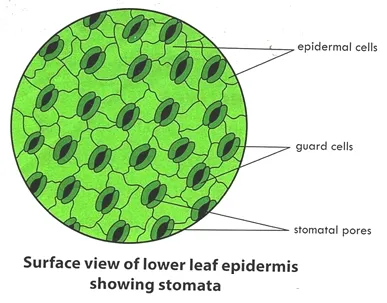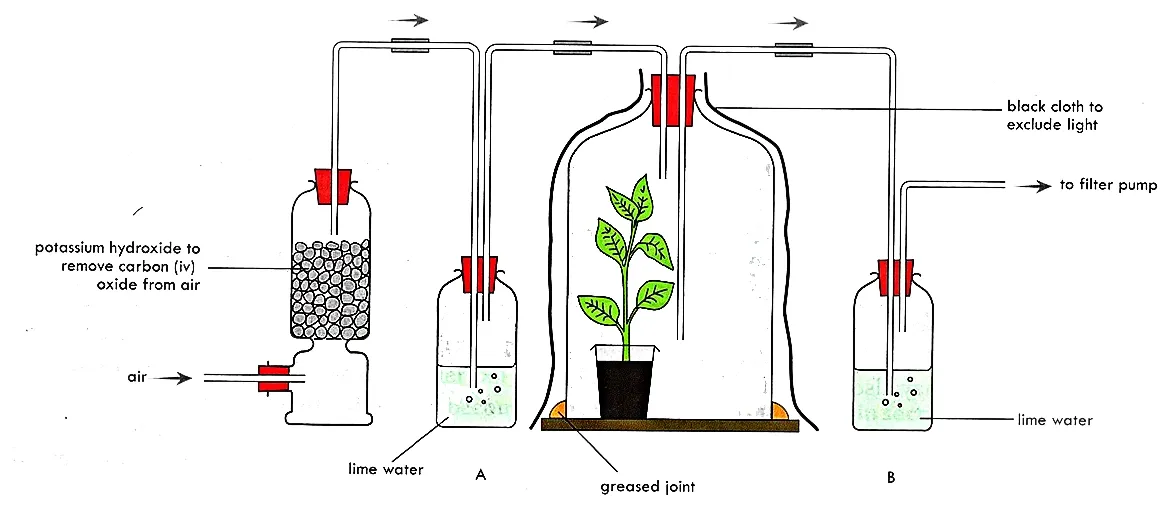Understanding Gaseous Exchange in Plants
Objectives
This blog post provides readers with the following objectives. The reader will be able to:
Gaseous Exchange in Plants
In higher plants the exchange of gases takes place through stomata and lenticel. Oxygen diffuses through the stomata or lenticel into air spaces and move into the cells. Carbon dioxide from the cells moves into the air spaces and diffuses out through the stomata and lenticel.
Structure of Plants Involve in Gaseous Exchange
Stomata
A stoma is formed by a pair of bean-shaped guard cells. The guard cells have the ability to open and close the stoma. The inner walls of the guard cells are thick and the outer walls thin. Guard cells contain chloroplasts. There are more stomata on the lower epidermis of the leaf than the upper epidermis. They are responsible for the interchange of gases for respiration and photosynthesis. The stomata allow for the loss of excess water in the form of water vapor, which also allows for cooling.
Lenticel
In woody stems, the entire surface is covered by bark which is impermeable to gases or water. However, there are certain pores in the layer of bark. These are called the lenticel. At the base of the lenticel are loosely arranged cells which allow the diffused gases to pass through them.
General Surface of the Roots
Gases diffuse in and out of the general surface of the roots. The gases are found in the soil surrounding the roots. Plants which grow in salty water show specialized roots called the pneumatophores. These are roots growing out of the surface of water with numerous pores on their surface for gaseous exchange.
Stomatal opening and closure [
Stomata usually open during the day when photosynthesis is occurring and closed at night.
Mechanism of stomatal opening and closure
When the solute concentration of
the guard cells is high, water flows from neighboring epidermal/cells into the
guard cells by osmosis. The volume and turgidity of the guard cells increase.
The thin outer walls of the guard cells stretch more than the thicker inner
walls, causing the guard cells/stomata to open.
When the solute concentration is low, water flows out of the guard cells by osmosis. The volume and turgidity decrease causing the guard cell to become flaccid and the stomatal pore is closed.
- Learn more about Stomatal Function on Britannica.
Importance of Gaseous Exchange
Photosynthesis: Gaseous exchange is essential for photosynthesis, where plants convert light energy into chemical energy. CO2 is a key reactant in the photosynthesis process.
- Explore Photosynthesis on Britannica.
Respiration: Plants also respire, taking in O2 and releasing CO2. This process occurs continuously, day and night, to produce energy for cellular activities.
- Understand Plant Respiration on ScienceDirect.
Transpiration: Gaseous exchange is linked to transpiration, the process where water vapor exits the leaf through stomata. Transpiration helps in nutrient transport and temperature regulation.
- Learn about Transpiration on Britannica.
Factors Affecting Gaseous Exchange
Light Intensity: Light triggers stomatal opening, increasing gaseous exchange. In the absence of light, stomata tend to close to conserve water.
- Discover the Impact of Light on Frontiers in Plant Science.
Water Availability: Adequate water supply keeps guard cells turgid, promoting stomatal opening. Water stress causes stomata to close, reducing gaseous exchange to minimize water loss.
- Learn about Water Stress on PubMed Central.
CO2 Concentration: Higher atmospheric CO2 levels can cause stomata to partially close, reducing water loss without significantly impacting photosynthesis.
- Explore CO2 Effects on PubMed Central.
Temperature: High temperatures increase the rate of gaseous exchange by causing stomata to open wider. However, extreme temperatures can lead to excessive water loss and stomatal closure.
- Understand Temperature Effects on jstor.
Humidity: High humidity levels reduce the gradient for water vapor diffusion, slowing down transpiration and gaseous exchange.
- Learn about the Role of Humidity on Frontiers in Plant Science.
Practical Applications
Agricultural Practices: Understanding gaseous exchange helps in optimizing watering, light exposure, and ventilation in crop management.
- For agricultural insights, visit Modern Agriculture Practices on PubMed Central.
Greenhouse Management: Controlled environments can regulate factors affecting gaseous exchange, improving plant growth and productivity.
- Discover Greenhouse Management on ScienceDirect.
Urban Planting: Knowledge of gaseous exchange is essential for selecting and maintaining plants in urban settings where pollution and varying microclimates can impact plant health.
- Learn about Urban Planting Strategies on PubMed Central.
Respiration in Plants
Aerobic Respiration
This is the breakdown of glucose in living cells to provide energy in the presence of oxygen. It’s carried out by the vast majority of organisms. The by-products of the reaction are water and carbon dioxide both of which are eliminated as waste products. More energy is released (2880KJ).
C6H12O6 + 6O2 → 6CO2 + 6H2O + ATP
Anaerobic Respiration
This occurs in some organisms when glucose is broken down to release energy in absence oxygen. Plant cells respire anaerobically, producing alcohol as a by-product. Less amount energy is released (210KJ)
C6H12O6 → 2CH3CH2OH + 2CO2 + ATP
Experiment to Show that Carbon Dioxide is given off During Aerobic Respiration
Aim: To show that carbon dioxide is given during aerobic respiration
Materials required: conical flask, capillary tubes, cork, potted plant, lime water.
Method
Set up the apparatus as shown in the figure.
A stream of Air is drawn through the apparatus using
pump or aspirator.
Carbon dioxide in the air entering the apparatus is
removed by soda lime in the first flask.
Small potted plant is placed in the bell jar.
Observation: the air drawn in the first conical flask should be clear of any carbon dioxide. The clear lime water in flask 1 will confirms that the air entering flask 2 is carbon dioxide free. The lime water in flask 2 will turn milky proving that carbon dioxide is coming from the plant in the bell jar.
Conclusion: the lime water
in flask 2 turns milky because the air given out from the plant contains carbon
dioxide.
Experiment
to Demonstrate that Heat is evolved During Respiration
Aim: To show heat is evolved during germination of seeds.
Material: vacuum flask, seeds (about 200 in numbers), thermometer, antiseptic, grease, rubber cork, tripod stand.
Procedure
Some bean seeds are soaked overnight in water (24 hours)
Divide the seeds into two equal groups and boil one group to kill the seeds.
Wash the boiled seeds with antiseptic to prevent them from bacterial decay.
Place the live seeds and dead seeds into separate vacuum flasks.
Insert a thermometer in each flask and plug the neck of the flask with cotton to hold the thermometer.
Observe and record thermometer readings between 6 to 24 hours.
Observation: there will be increase in temperature of the un-boiled seeds, indicating heat production during germination. There will be no rise in temperature of the boiled seeds.
Inference: his shows that heat is produced by respiring seeds. Dead seeds do not
respire and the temperature does not rise.






